As the virus spreads like wildfire across American communities, the consequences are already altering parts of daily life
“What we have to understand is that our health system is at a very different place than we were in previous surges,” professor of emergency medicine Dr. Esther Choo told CNN on Saturday. “We have extremely high numbers of just lost healthcare workers, we’ve lost at least 20% of our healthcare workforce, probably more.”
“This strain is so infectious,” Choo added, “that I think all of us know many, many colleagues who are currently infected or have symptoms and are under quarantine.”
“That’s a different type of one-two punch: people going into the hospitals … and all of the healthcare workers are out of the workforce,” he told CNN.
In Ohio, the mayor of Cincinnati declared a state of emergency due to staffing shortages in the city’s fire department following a rise in Covid-19 infections, saying in the declaration that if the problem goes unaddressed, it would “substantially undermine” first responders’ readiness levels.
“We’re seeing a surge in patients again, unprecedented in this pandemic,” Dr. James Phillips, chief of disaster medicine at George Washington University Hospital, warned on Saturday. “What’s coming for the rest of the country could be very serious and they need to be prepared.”
Vast majority of patients still the unvaccinated, expert says
And about 33.4% of those who are fully vaccinated have received their booster doses, the data shows.
“If you’re unvaccinated, that’s the group still at highest risk,” Dr. William Schaffner, a professor at Vanderbilt University Medical Center, told CNN Saturday. “The adults that are being admitted to my institution, the vast majority continue to be unvaccinated.”
Dr. Catherine O’Neal, the chief medical officer at Our Lady of the Lake Regional Medical Center in Baton Rouge, Louisiana, said their facility has seen hospital admissions and emergency department visits triple in the past week.
“What we’re seeing is that… our vaccinated patients aren’t getting sick and our frail, multiple co-morbidities vaccinated patients do need admission, but their admissions are shorter and they’re able to leave the hospital after several days,” O’Neal said. “Our unvaccinated patients are the sickest patients, they’re the patients most likely to be on the ventilator.”
The hospital is stretched so thin by the surging numbers, they’re concerned they may not be able to “take care of patients the way we want to take care of them by tomorrow,” O’Neal added.
“We’re running out of tests, we’re running out of room, we’re inundated in the ER,” she added.
Three large Georgia school districts return to remote classes
An average of 378 children were admitted to the hospital with Covid-19 on any given day over the week that ended December 28, according to data published last week from the CDC and the US Department of Health and Human Services.
That’s more than a 66% jump from the previous week — and breaks the country’s previous record of an average of 342 children admitted to hospitals daily, that was seen at the end of August and early September.
The virus is not specifically targeting children this time, Hotez told CNN on Saturday, but because more virus is now circulating in communities, it’s more likely that more children will get infected as well.
“It may be the case that in some school districts, where things are so raging right now in terms of Omicron for the next couple of weeks, and it may be prudent to delay things a couple more weeks,” Hotez said. “It’s going to be a very challenging time, people are going to have to be patient.”
In Georgia, three large Atlanta-area school districts will be starting class remotely.
Atlanta Public Schools (APS) announced all district schools will operate virtually through January 7 for all students and staff, citing the surging cases.
“Due to the rapid rise in positive cases in the metro Atlanta area, students will begin virtual classes Tuesday, Jan. 4 through Friday, Jan. 7.,” a statement on Saturday said.
“Our current plan is to resume in-person instruction on Monday, Jan. 10,” it added. “All APS staff are required to report to their work location Monday, Jan. 3 for mandatory COVID-19 surveillance testing, unless they are ill. The data collected from staff testing will be used for future planning.”
The move, APS said, will allow students and staff to be tested and to isolate and quarantine as needed per the CDC’s and health department’s guidelines.
CNN’s Claudia Dominguez contributed to this report.
![]()


